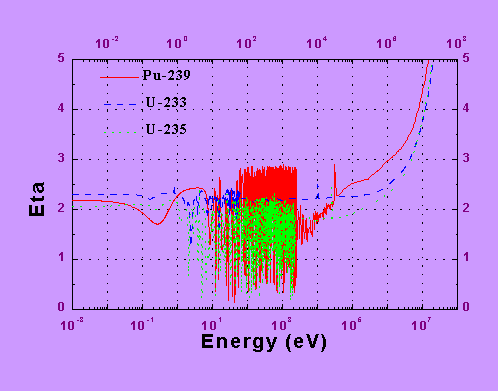Breeder Reactor
Fissile, fertile and the concept of breeder reactors: A ‘fissile’ material is one which fissions with neutron of any energy. U-233, U-235, Pu-239, and Pu-241 are examples for fissile nuclides. A ‘fertile’ nuclide is one which leads to the production of a fissile nuclide, on absorption of a neutron. Th-232 and U-238 are well known fertile nuclides. It is seen from the detailed cross-section behaviour of these fertiles, that they support fission only with very fast neutrons, i.e. beyond about 1 MeV. At lower energies they have high potential of absorption of neutrons, and consequently converting to fissile nuclides. Such a conversion, wherein a nucleus, which is not ordinarily fissile, is converted to fissile is called breeding. Thus the concept of breeding is a concept of artificial production of fuel for nuclear reactors. This is explained further below:
The term ‘breeding’ refers to production of more fissile than consumed, in a reactor. Nuclear transmutations take place in a reactor due to continual nuclear interactions and radioactive decays, leading to the production of a variety of new nuclei, not present in the initial feed of materials in the reactor. Some of the newly produced nuclei are advantageous and some disadvantageous, but such new arrivals are inevitable. The new arrivals include new ‘fissile’ material and this becomes the most prominent among the materials newly produced in the transmutations. The initial feed of the fuel is made of the fissile material (U-235, U-233 or Pu-239) and the fertile material (U-238 or Th-232) in a calculated proportion. The following are the routes in which a fertile nucleus gets transmuted into a fissile nucleus:


In other words, a neutron capture in a fertile nuclide, followed by two successive b emissions, leads to the production of a fissile nuclide. The relevant half-lives of b emission are given in the brackets. U-238 is the fertile material used in most of the reactors and hence the fissile material Pu-239 is inevitably generated in each of them. It must be noted that the newly generated nuclei undergo all probable interactions and decays, so that they have both production and destruction routes. However, through a proper combination of fissile, fertile and other materials arranged in a carefully worked out geometry, together with proper reprocessing schemes, it is possible to realize a fissile production rate that exceeds the fissile consumption rate. A reactor system in which this has been realized is called a ‘breeder reactor’.
Conversion of fertile to fissile is possible over a wide energy range, but ‘adequate’ conversion is possible only in an appropriate range. In a reactor, the conversion depends on the available neutrons over and above what is required to sustain the fission chain and the inevitable losses due to leakage and unproductive absorptions. The parameter h governs conversion probability. h is basically defined for a fissioning nucleus, but could be derived also for a mixture of fissionable materials.
h = No. of neutrons produced (in fission) ¸ No. of neutrons absorbed
= nsf / (sf + sc) = n/(1+a), where
n = No. of neutrons produced per fission; a = sc/sf .
All the above parameters depend on neutron energy. n generally increases with energy. a and hence h show marked variation with fluctuations due to cross-section resonances. The figure below shows the energy dependence of h for the three fissile nuclides viz. U-235, Pu-239 & U-233.

h of the major fissile nuclides
If breeding (fissile production > fissile consumption) is desired then h must satisfy a minimum criterion, which could be logically derived as follows:
No. of neutrons absorbed by fissile = 1 (say)
No. of neutrons produced = h (by definition)
Out of h neutrons, one must be reserved to continue the fission chain in the fissile. Some L neutrons would be lost unproductively (due to parasitic capture and leakage). Hence the no. of neutrons available for capture by the fertile nucleus to do conversion is given by h - (1+L). Obviously this must be ³ 1. Thus,
h - (1+L) ³ 1 or h ³ 2 + L.
Hence the fissile material chosen and the energy spectrum of the neutrons must be such as to have h as much greater than 2 as possible. From the above, the ‘breeding ratio’ could be written as BR = h - (1+L), since this represents the number of neutrons absorbed in the fertile nucleus for every neutron absorbed in the fissile, assuming that the fertile absorption leads to conversion.
From the energy variation of h, the following are observed:
At energies close to thermal (0.025eV), only U-233 has h well above 2. At very high energies (>1 MeV), all the nuclides show marked increase in h. It is impractical to sustain neutron spectrum above 1 MeV, mainly due to inevitable energy degradation by inelastic scattering, and the fast spectrum is generally in the range 10 keV – 1 MeV, with its maximum around a few 100 keV. In this range, Pu-239 has h well above 2, and hence has become the undisputed fissile candidate for breeder reactors with fast neutrons.
The degree of conversion of fertile to fissile is given by the conversion ratio (CR), defined as
CR = Fissile mass produced = FP.
Fissile mass destroyed FD
CR is called breeding ratio (BR) if it exceeds unity indicating production in excess of consumption.
BR = FP > 1.
FD
The breeding gain G= BR-1, is given by
G = FG/FD
= Fissile gained / Fissile destroyed.
As most of the fissile absorption in the thermal reactor happens in the 0.01 to 1eV range, and in the fast reactor above 10 keV, the best fissile fuel is U-233 for a thermal reactor and Pu-239 for fast reactor with respect to breeding gain, based on the h values.